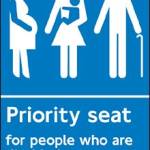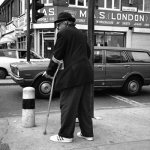Let’s start with a simple fact: I’m not disabled, registered or otherwise. Many are and cope with their physical or mental issues in various ways. There has been an ongoing debate about the current government policy towards those with “disability” (and I recognise that language is very sensitive in this respect and likely to cause great offence to those who suffer prejudice on top of their actual condition), which they say is designed to “help them back to work” but in practice is a means to reduce the benefits budget and leaves many utterly helpless.
However, that is not the subject of this blog. My concern here is the way ordinary people react to those who have difficulty in manoeuvring, and it springs from the fact that I have a chronic arthritic condition in my right ankle – an impairment that detracts from my mobility. Granted that a recent change of medication has helped slightly, but the situation has been true for some years now: the pain is constant and comes in three levels:
- Standard level is what I put up with on a day-to-day basis
- Enhanced level causes me to stop to rest the ankle and then to move at a much slower pace and sit down for some while as soon as possible
- Crisis level is cry out loud painful and results in swelling and a residual ache that lasts for a day at a time. Under those circumstances I have to lie down and rest it for a long period.
I’m neither asking for nor expecting sympathy, and what I go through is no more or less suffering than anyone else would anticipate in the ageing process. No matter how fit you stay, something will go wrong and require attention, and the older you get the more likely it is that you will acquire along the way conditions that medical science cannot simply fix in one easy procedure. Luckily, mine is not that serious and there are very many people with visible and invisible conditions that make their lives far more wretched than the relatively minor inconvenience I endure.
However, the need to live a normal life unhindered means I have to find some coping mechanisms, one of which is that I now use crutches to help me get around. They provide some support and when we ratchet up to the higher pain levels the support of crutches is essential. And since work and the need to pay the bills is no respecter of injury, I still have to commute into central London in the pursuit of paying client work, crutches and all.
The commute has started with a drive to Leytonstone, where, thanks to the good offices of a kind friend, I park at a church car park, walk a quarter mile or so down to the tube station, then hop on a Central Line tube to Liverpool Street, change to Circle Line and stagger from Euston Square to the client premises. In fact I also have to get around London to visit various CCGs and Acute Trusts, so that’s many more tube journeys and in some cases uncomfortable walks.
Excluding these extra journeys, the typical commute in and out of London takes me well over 2 hours, sometimes a lot longer, and on top of the working day is pretty darned exhausting, certainly much harder than the days when I used to get the train in from Broxbourne, and all the more so since standing in a packed carriage can be mighty uncomfortable for an extended period.
My natural inclination is to let it pass in that eventuality rather than selfishly demanding a seat – and let’s face it, many people do prefer to “suffer in silence” than be thought of as moaning about their lot to get special treatment. However, one of the main compensations is to see the reaction of ordinary Londoners to a fellow passenger on crutches, bearing in mind that the first seat on either side of every carriage is marked with a sign indicating priority to “disabled people, pregnant women or those less able to stand.”
Now it’s certainly true that some people insist on staying in their seat come what may, and a number more drop off to sleep and thus never worry about who might need their seat more, but the common experience is that people go out of their way to offer me and other walking wounded their seats. More than that, some fellow standers are so indignant about the situation that they insist on rousing people in the nearby seats and insist that they stand so I can sit. In fact, offers of help and checks that I am able to cope come at very regular intervals throughout journeys, which is a welcome sign that the majority of people in the capital are fundamentally decent and do think of others less fortunate than themselves, contrary to the received wisdom that we are all a bunch of selfish Darwinian survivors and devil take the hindmost.
It’s flattering to be sure, though I can’t help feeling a tad guilty in case there are others around more deserving, maybe a recognition that this is an acceptance that I am no longer the fit and active bloke who used to do a punishing gym regime several mornings a week. But that feeling extends further: do I make do and climb stairs and escalators with everyone else or admit failure and get the lift thoughtfully provided in most tube stations? The only time I generally get a lift (excepting Covent Garden and Belsize Park where you have to get a lift) is Euston, and that’s because (a) the entrance into which I arrive from the street goes past the lift, and (b) it is the Northern Line, which happens to be the deepest of all underground tunnels under London town.
Back on street level, there are further obstacles to avoid, notably uneven paving slabs (I once tore ankle ligaments on a dodgy pavement in London, ironically the one not suffering now), blind drivers, will-they-won’t-they crossings and much more besides. You can be totally able bodied and take your life in your hands, so crutches don’t help. Or maybe they do in one respect – at least I have a weapon to hand in the unlikely event of being attacked on the streets of London.
The reality is that people look at you in a different way if you limp or your gait is awkward, impacted by bodily disfunction. There is a small minority who will assume you are mentally impaired because you are bodily impaired, though thankfully very few treat those with permanent physical conditions as badly as once they might have done. The success of Paralympics may have contributed greatly to the level of understanding and appreciation of the capabilities of people with disabilities, but wheelchair users will tell you they have a very long way to go before all buildings are accessible, let alone treating them as equal to any able-bodied person.
My client sponsor is a person of restricted height and recently fractured a hip. After weeks of recuperation she is finally ready to come back to work, but can’t return to the building in which much of the critical work is conducted. Why? Because this relatively new building doesn’t have a lift from the car park. We are all entitled by law to help and support from our employers, but it would be good to know that access is taken into account in all buildings at all times.
My final thought is this: whoever you are, don’t patronise people afflicted in any way, nor especially to undermine their independence; but do offer them a seat if they need it, and do assist if they have a logistical issue, much as you would help a mum carry her push-chair down a flight of stairs. It may well be appreciated.





